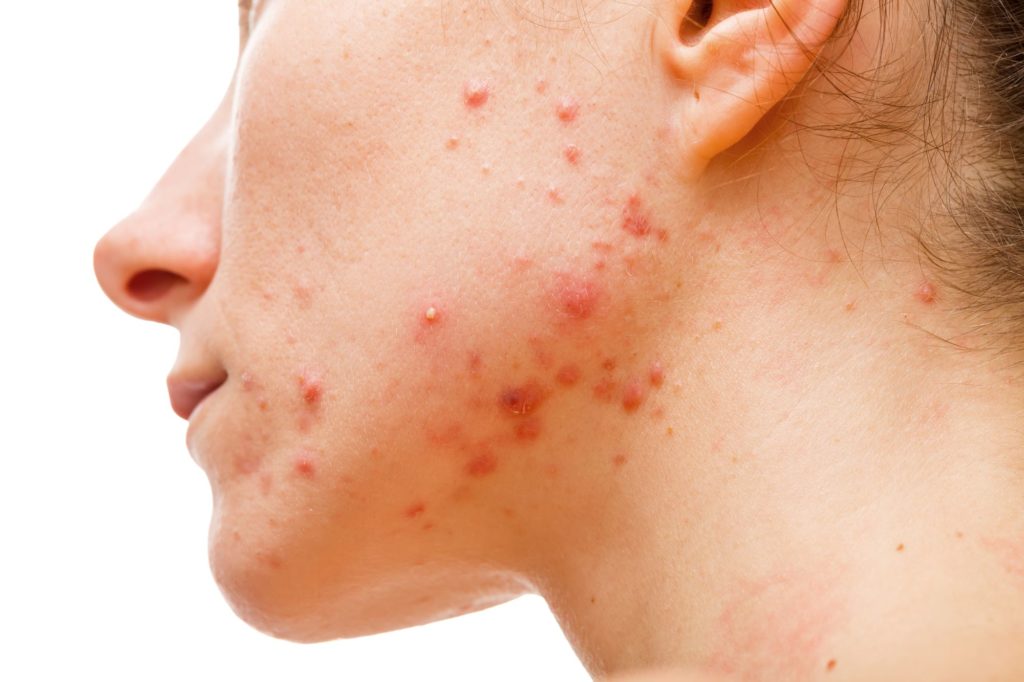Acne
Acne is the most common skin condition in the United States. It most commonly affects teenagers and adult women but can occur at any age. Acne can develop on almost any part of the body, including face, neck, arms, back, legs and buttock. It most commonly affects the T-Zone in teenagers and the jawline and chin in adult women.
People with acne may have any of these blemishes:
- Blackheads
- Whiteheads
- Papules
- Pustules (what many people call pimples)
- Cysts
- Nodules

What Causes Acne?
There are many factors that contribute to acne, including genetic predisposition. Among teens and adults, hormones play a key role. Another common factor of acne is pores filling with oil and bacteria, which can spread into the skin and cause inflammation to occur.
There are many factors that contribute to acne, one of which is genetic predisposition. Among teens and adults, hormones also play a key role. Increase in sweating and certain topical products may also contribute to acne. It is controversial whether specific foods contribute to acne.
What are the Treatment Options for Acne?
There are many treatment options available for acne. Mild acne is typically treated with a combination of topical medications targeted towards killing bacteria, renewing skin texture, and shrinking pores. Moderate to severe acne may require oral medications such as oral antibiotics or anti-androgen medications in addition to topical treatments. When needed, we are also experienced in treating patients that have severe or recalcitrant acne with isotretinoin (Accutane). All of our patients are closely monitored and treatment plans are modified if patients are not responding to treatments.
It usually takes up to 8-12 weeks before the benefits of acne treatments are visible. Patients should know that acne is a very treatable condition and is typically very responsive to treatment. There are many very affordable, effective treatments for acne. We, at NW Dermatology, strongly feel that treatment needs to be individualized and fit the patient’s lifestyle and level of comfort. We are very comfortable having discussions with our patients about available treatment options and which treatment options will best fit their needs. We recognize that some patients prefer a very conservative approach while other patients prefer a more aggressive approach. All of our patients are closely monitored and treatment plans are modified if patients are not responding to treatments or the treatment plan does not meet the patient’s expectations.
In our experience, it is important for patients to treat hyperpigmentation that occurs secondary to acne. Post-inflammatory hyperpigmentation remains on the skin for 6-12 months after the inflammation from the acne resolves whereas scarring is permanent. This hyperpigmentation, which is often confused with acne scarring, can be very aggravating for patients. There are treatments available to improve and more quickly resolve this discoloration.
Blu-U Light Acne Treatment
Blu-U blue light is a non-invasive therapy that utilizes safe and painless blue light in the treatment of acne without the use of antibiotics. Blu-U light treats acne by shrinking the skin’s oil glands. This can drastically reduce the amount of oil within the pores thereby reducing blackheads and whiteheads. Blu-U light also destroys the bacteria on the skin that causes breakouts. Blu-U light may also improve the skin’s overall texture and may speed the resolution of acne-induced skin discoloration
HydraFacial
HydraFacial utilizes a combination of cleansing, skin exfoliation, extraction, and hydration along with the added protection of antioxidants. It is performed in the office as a supplementary treatment for acne and can help your skin look and feel beautiful immediately after the procedure.
Vi peel
Vi peels are a blended peel formulated with trichloroacetic acid (TCA), salicylic acid, retinoic acid, phenol, and vitamin C. A VI Peel is ideal for treating acne and hyperpigmentation that occurs after acne resolves. Vi peel improves skin tone and texture, clears acne, reduces acne scars, and decreases the appearance of pores. It takes approximately 1 week for the peeling to resolve and multiple treatments may be needed to achieve the desired results.
